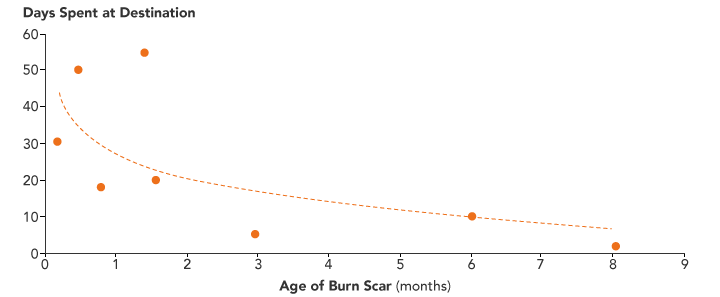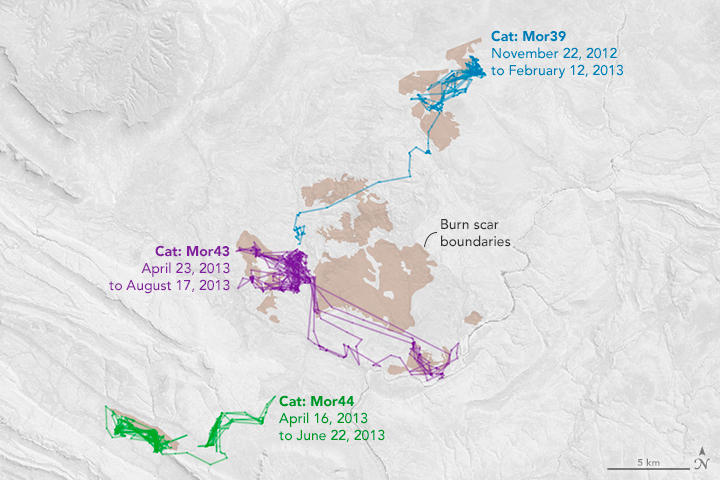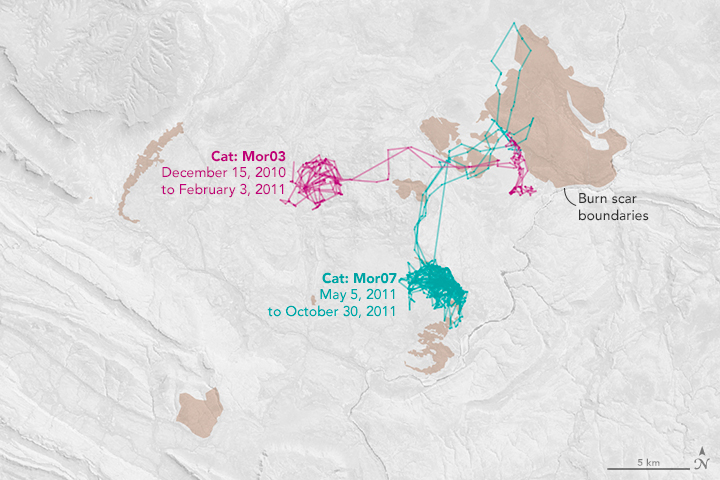Feral cats in Australia usually don’t range too far for food. Hunts are usually limited to their home territory, just a few kilometers across. But there is at least one exception to the rule: the cats appear to travel pretty far for the chance to hunt on land that has recently burned. The phenomenon was recently described by Hugh McGregor and colleagues affiliated with the Australian Wildlife Conservancy (AWC) and University of Tasmania.
According to AWC, feral cats kill millions of native animals per day across Australia. To reduce the impact on native species, researchers want to better understand the hunting behavior of these cats. Observations have shown that within their home territory, they prefer to hunt on intensely burned land. One reason might be that these fires change the structure of the habitat from grassy savanna to burned and barren. Small mammals become more exposed, and easier for cats to detect and capture.
But will cats venture to burned areas beyond their territory for the chance at a good hunt? If so, how far will they go? To find out, McGregor and colleagues used GPS collars to track the movements of 32 cats in the Kimberley region of northwestern Australia between 2010 and 2013. The paths of five of those cats are represented by colored lines on the images above. The background images were acquired with the Operational Land Imager (OLI) on Landsat 8 and show the topography of the region. Brown-shaded areas depict the extent of burn scars from intense fires that occurred in 2010-2011 (top image) and 2012-2013 (second image).
Note the tangle of movement within the home range, followed by relatively direct paths to and from the burn scars. The cats’ journeys ranged up to 12.5 kilometers, far beyond their home territory. The willingness to travel suggests that even a low-density population of feral cats can have a large, wide-ranging effect on native species.
According to AWC, feral cats kill millions of native animals per day across Australia. To reduce the impact on native species, researchers want to better understand the hunting behavior of these cats. Observations have shown that within their home territory, they prefer to hunt on intensely burned land. One reason might be that these fires change the structure of the habitat from grassy savanna to burned and barren. Small mammals become more exposed, and easier for cats to detect and capture.
But will cats venture to burned areas beyond their territory for the chance at a good hunt? If so, how far will they go? To find out, McGregor and colleagues used GPS collars to track the movements of 32 cats in the Kimberley region of northwestern Australia between 2010 and 2013. The paths of five of those cats are represented by colored lines on the images above. The background images were acquired with the Operational Land Imager (OLI) on Landsat 8 and show the topography of the region. Brown-shaded areas depict the extent of burn scars from intense fires that occurred in 2010-2011 (top image) and 2012-2013 (second image).
Note the tangle of movement within the home range, followed by relatively direct paths to and from the burn scars. The cats’ journeys ranged up to 12.5 kilometers, far beyond their home territory. The willingness to travel suggests that even a low-density population of feral cats can have a large, wide-ranging effect on native species.

acquired 2010 - 2013
The level of impact varied, however, as not all fires are equally appealing. Cats preferred fires that were both intense and recent. The average length of stay at a burn scar was 15 days. But as the graph above shows, some stayed longer—up to 50 days or more—if the burn was recent. Conversely, cats lingered less at older burn sites. The researchers speculate that as grasses begin to return, prey became less vulnerable.
It’s still not clear how the cats detected and navigated to burn scars. Journeys usually began at least five days after a fire burned, but it’s possible that cats retained the memory of the direction of smoke or some other cue.
It’s still not clear how the cats detected and navigated to burn scars. Journeys usually began at least five days after a fire burned, but it’s possible that cats retained the memory of the direction of smoke or some other cue.
References and Related Reading
- Australian Wildlife Conservancy (2016) Feral cat research. Accessed June 8, 2016.
- McGregor, H. et al. (2016, March 2) Extraterritorial hunting expeditions to intense fire scars by feral cats. Scientific Reports, (6), 22559.
- McGregor, H. et al. (2014, October 15) Landscape Management of Fire and Grazing Regimes Alters the Fine-Scale Habitat Utilisation by Feral Cats. PLoS ONE, 9 (10), e109097.
NASA Earth Observatory maps by Joshua Stevens, using data courtesy of Hugh W. McGregor, et al. (2016). Caption by Kathryn Hansen.
- Instrument(s):
- Landsat 8 - OLI
- GPS
- source


No comments:
Post a Comment